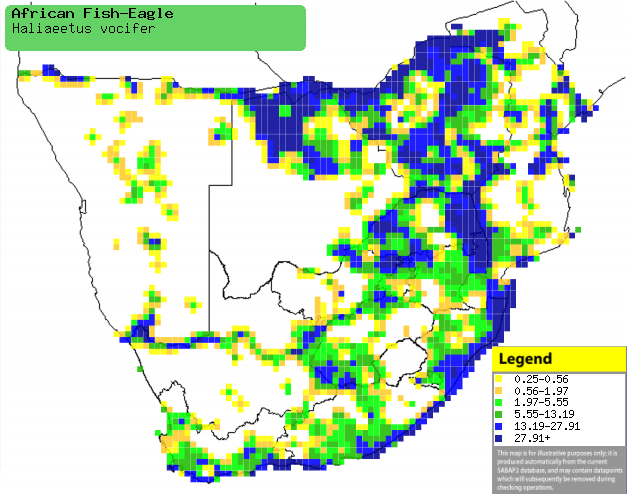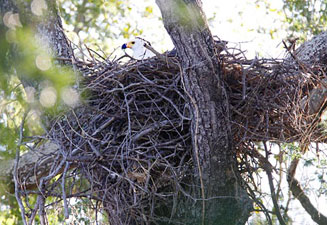|
Haliaeetus vocifer (African
fish-eagle)
Visarend [Afrikaans]; Ingqolane, Unomakhwezana [Xhosa];
iNkwazi [Zulu]; Mpungu [Kwangali]; Hungwe (also applied to Secretary bird)
[Shona]; Inkwazi [Swazi]; Nghunghwa [Tsonga]; Kgoadirê [Tswana];
Afrikaanse zeearend, [Dutch]; Pygargue vocifer [French]; Schreiseeadler
[German]; Águia-pesqueira-africana [Portuguese]
Life
> Eukaryotes >
Opisthokonta
> Metazoa (animals) >
Bilateria >
Deuterostomia > Chordata >
Craniata > Vertebrata (vertebrates) > Gnathostomata (jawed
vertebrates) > Teleostomi (teleost fish) > Osteichthyes (bony fish) > Class:
Sarcopterygii (lobe-finned
fish) > Stegocephalia (terrestrial
vertebrates) > Tetrapoda
(four-legged vertebrates) > Reptiliomorpha > Amniota >
Reptilia (reptiles) >
Romeriida > Diapsida > Archosauromorpha > Archosauria >
Dinosauria
(dinosaurs) > Saurischia > Theropoda (bipedal predatory dinosaurs) >
Coelurosauria > Maniraptora > Aves
(birds) > Order: Falconiformes
> Family: Accipitridae
Distribution and habitat
Occurs across sub-Saharan Africa; in southern Africa it is locally common in much of the region,
excluding the arid Namib Desert, Kalahari and much of the Karoo. It generally
favours large water bodies, ranging from estuaries to rivers and man-made
impoundments, such as dams.
|
 |
|
Distribution of African fish eagle in southern Africa,
based on statistical smoothing of the records from first SA Bird Atlas
Project (©
Animal Demography unit, University of
Cape Town; smoothing by Birgit Erni and Francesca Little). Colours range
from dark blue (most common) through to yellow (least common).
See here for the latest distribution
from the SABAP2. |
Movements and migrations
Mainly sedentary, although both
adults and fledglings may disperse from the nest territory after the
breeding season.
Food
Specialises in hunting fish,
gracefully swooping down to the water surface to grab a fish with its
talons; it may even catch fish straight from the waves of the sea! Fish that weigh under
about 2 kg are lifted out of the water and carried to a
perch to be eaten, but if the fish is larger than 3 kg, the fish-eagle drags to the
shore using its wings as paddles. It also hunts other animals living on or near
the water, such as waterbirds, reptiles and small mammals. The following food items have been recorded
in its diet:
- fish
- tilapia (Cichlidae)
- catfish
- Clarias gariepinus (Sharptooth catfish)
- mullet (Mugilidae)
- Cyprinus caprio (Carp)
- birds
- Bubulcus
ibis (Cattle egret adults)
- chicks (taken from the ground or water)
- chicks and eggs (taken from nests)
- reptiles
- mammals
Breeding
- Monogamous, territorial solitary nester, performing a courtship display in
which the male repeatedly dives at the female, who presents her talons.
- The nest (see image below) is mainly built by the female in roughly two
months, consisting of a large platform of sticks or Papyrus (Cyperus
papyrus), lined with grass, papyrus heads, other aquatic plants and
occasionally weaver nests. Due to the considerable effort required to build
the nest, the same structure is often reused over multiple breeding seasons, although a breeding pair may have multiple nests, alternating between them
each year. It is typically placed on a cliff ledge or at the top of a tall tree,
usually less than 100 metres from water; it has been recorded to use the
following trees for nesting:
- indigenous trees
- Acacia
- Euphorbia
- Ficus (figs)
- alien trees
 |
|
|
African fish-eagle nest, Levuvhu River, Kruger
Park, South Africa. [photo Warwick Tarboton ©] |
|
- Egg-laying season is from April-August, peaking from May-June.
- It lays 1-4, usually 2 eggs, which are mainly incubated by the female
for about 42-45 days, while the male may take over for an hour or two so
that she can hunt.
- The chicks are brooded for much of the nestling period; the older
chick often ruthlessly attacks the younger bird and prevents it from getting
food, even if there is plenty of food to go around. The parents ignore this
behaviour, and by seven weeks the competition for food between siblings intensifies,
although they are less aggressive to each other. The younger chick either dies or grows to
be a lot weaker than its siblings, in fact 2-3 chicks often survive to
fledge at 70-75 days old. They become fully independent after another two
months or so.
Threats
Not threatened globally, but Near-threatened in
Namibia due its small population there.
References
-
Hockey PAR, Dean WRJ and Ryan PG 2005. Roberts
- Birds of southern Africa, VIIth ed. The Trustees of the John Voelcker
Bird Book Fund, Cape Town.
|
